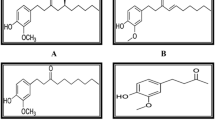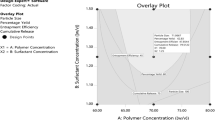Abstract
Phytic acid (PA) has momentous chemotherapeutic potential. Due to the chelate formation and rapid elimination, it is not popular in cancer treatment. The present work was inquested to develop a surface-modified nanoformulation of PA which prevents its speedy elimination and maximizes chemotherapeutic action. Chloroauric acid was reduced with pectin to produce pectin-gold nanoparticles (PGNPs). PGNPs were incubated with PA and jacalin for drug loading and surface modifications, respectively, to form PA-loaded jacalin-pectin-gold nanoparticles (PA-J-PGNPs). Formulation(s) were assessed for various pharmaceutical/pharmacological parameters. To validate the efficacy against colon carcinogenesis, formulation(s) were assessed in 1,2-dimethylhydrazine (DMH)-treated Wistar rats. DMH treatment distorted colonic architecture, oxidative, and hemodynamic parameters, which were favorably restored by PA-J-PGNP administration. To further confirm our deliberations, formulation(s) were also examined against DMH-altered metabolic changes and expression of markers pertaining to cellular proliferation, which was reinstated by PA-J-PGNPs. Our findings establish PA formulation(s) as a promising approach for suppression of colon carcinogenesis.








Similar content being viewed by others
References
Singh S, Kotla NG, Tomar S, Maddiboyina B, Webster TJ, Sharma D, et al. A nanomedicine-promising approach to provide an appropriate colon-targeted drug delivery system for 5-fluorouracil. Int J Nanomedicine. 2015;10:7175.
Liu J, Zhang L, Jia Y, Hu W, Zhang J, Jiang H. 558301. Preparation and evaluation of pectin-based colon-specific pulsatile capsule in vitro and in vivo. Arch Pharm Res. 2012;35(11):1927–34.
Izadi Z, Divsalar A, Saboury AA, Sawyer L. β-lactoglobulin–pectin nanoparticle-based oral drug delivery system for potential treatment of colon cancer. Chem Biol Drug Des. 2016;88(2):209–16.
Shukla K, Raj P, Kumar A, Kumar M, Kaithwas G. Effect of monotherapy and combination therapy of pantoprazole and aprepitant in gastric esophageal reflux disease in albino rats. Sci World J. 2014;2014:1–7.
Khinchi P, Saha S, Saraf SA, Kaithwas G. Combination therapy of gamma-aminobutyric acid derivative promotes proton pump inhibitor based healing of reflux esophagitis in animal model. Pharmacol Rep. 2014;66(1):165–8.
Bird RP. Observation and quantification of aberrant crypts in the murine colon treated with a colon carcinogen: preliminary findings. Cancer Lett. 1987;37(2):147–51.
Kumar S, Singh M, Rawat JK, Gautam S, Saraf SA, Kaithwas G. Effect of rutin against gastric esophageal reflux in experimental animals. Toxicol Mech Methods. 2014;24(9):666–71.
Singh M, Kanoujia J, Parashar P, Arya M, Tripathi CB, Sinha V, et al. Augmented bioavailability of felodipine through an α-linolenic acid-based microemulsion. Drug Deliv Transl Res .2017;1–22.
Arya M, Tiwari P, Tripathi CB, Parashar P, Singh M, Sinha P, et al. Colloidal vesicular system of phytic acid to counteract DMBA induced dysregulation of markers pertaining to cellular proliferation/differentiation and inflammation of epidermal layer in mouse model. Mol Pharm. 2017;14(3):928–39.
Guolin H, Jeffrey S, Kai Z, Xiaolan H. Application of ionic liquids in the microwave-assisted extraction of pectin from lemon peels. J Anal Methods Chem. 2012;2012:1–8.
Koperuncholan M. Bioreduction of chloroauric acid (HAuCl4) for the synthesis of gold nanoparticles (GNPs): a special empathies of pharmacological activity. Int J Phytopharm. 2015;5(4):72–80.
Marangoni VS, Paino IM, Zucolotto V. Synthesis and characterization of jacalin-gold nanoparticles conjugates as specific markers for cancer cells. Colloids Surf B Biointerfaces. 2013;112:380–6.
Daneluti ALM, Matos JR. Study of thermal behavior of phytic acid. Braz J Pharm Sci. 2013;49(2):275–83.
Verma J, Kanoujia J, Parashar P, Tripathi CB, Saraf SA. Wound healing applications of sericin/chitosan-capped silver nanoparticles incorporated hydrogel. Drug Deliv Transl Res. 2017;7(1):77–88.
Madhusudhan A, Reddy GB, Venkatesham M, Veerabhadram G, Kumar DA, Natarajan S, et al. Efficient pH dependent drug delivery to target cancer cells by gold nanoparticles capped with carboxymethyl chitosan. Int J Mol Sci. 2014;15(5):8216–34.
Suganya KU, Govindaraju K, Kumar VG, Karthick V, Parthasarathy K. Pectin mediated gold nanoparticles induces apoptosis in mammary adenocarcinoma cell lines. Int J Biol Macromol. 2016;93:1030–40.
Liu L, Fishman ML, Kost J, Hicks KB. Pectin-based systems for colon-specific drug delivery via oral route. Biomaterials. 2003;24(19):3333–43.
Dongowski G, Lorenz A, Anger H. Degradation of pectins with different degrees of esterification by Bacteroides thetaiotaomicron isolated from human gut flora. Appl Environ Microbiol. 2000;66(4):1321–7.
Skrzydlewska E, Stankiewicz A, Sulkowska M, Sulkowski S, Kasacka I. Antioxidant status and lipid peroxidation in colorectal cancer. J Toxicol Environ Health A. 2001;64(3):213–22.
Skrzydlewska E, Sulkowski S, Koda M, Zalewski B, Kanczuga-Koda L, Sulkowska M. Lipid peroxidation and antioxidant status in colorectal cancer. World J Gastroenterol. 2005;11(3):403–6.
Raj P, Singh M, Rawat JK, Gautam S, Saraf SA, Kaithwas G. Effect of enteral administration of α-linolenic acid and linoleic acid against methotrexate induced intestinal toxicity in albino rats. RSC Adv. 2014;4(104):60397–403.
Kaithwas G, Majumdar DK. In vitro antioxidant and in vivo antidiabetic, antihyperlipidemic activity of linseed oil against streptozotocin-induced toxicity in albino rats. Eur J Lipid Sci Technol. 2012;114(11):1237–45.
Khare S, Chaudhary K, Bissonnette M, Carroll R. Aberrant crypt foci in colon cancer epidemiology. Methods Mol Biol. 2009;472:373–86.
Wargovich MJ, Brown VR, Morris J. Aberrant crypt foci: the case for inclusion as a biomarker for colon cancer. Cancers (Basel). 2010;2(3):1705–16.
Vucenik I, Stains J. Cancer preventive and therapeutic properties of PA: efficacy and mechanisms. Period Biol. 2010;112(4):451–8.
Liu G, Song Y, Cui L, Wen Z, Lu X. Phytic acid suppresses growth and induces apoptosis in HT-29 colorectal cancer cells in culture: PI3K/Akt pathway as a potential target. Int J Clin Exp Pathol. 2015;8(2):1402–10.
Shafie NH, Mohd Esa N, Ithnin H, Md Akim A, Saad N, Pandurangan AK. Preventive phytic acid extracted from rice bran inhibits colorectal cancer through involvement of Wnt/β-catenin and COX-2 pathways. Biomed Res Int. 2013;2013:1–10.
Osaki M, Ma O, Ito H. PI3K-Akt pathway: its functions and alterations in human cancer. Apoptosis. 2004;9(6):667–76.
Edelman MJ, Hodgson L, Wang X, Kratzke RA, Vokes EE. Cyclooxygenase-2 (COX-2) as a predictive marker for the use of COX-2 inhibitors in advanced non-small-cell lung cancer. J Clin Oncol. 2012;30(16):2019–20.
Chan ECY, Koh PK, Mal M, Cheah PY, Eu KW, Backshall A, et al. Metabolic profiling of human colorectal cancer using high-resolution magic angle spinning nuclear magnetic resonance (HR-MAS NMR) spectroscopy and gas chromatography mass spectrometry (GC/MS). J Proteome Res. 2008;8(1):352–61.
Leichtle AB, Nuoffer J-M, Ceglarek U, Kase J, Conrad T, Witzigmann H, et al. Serum amino acid profiles and their alterations in colorectal cancer. Metabolomics. 2012;8(4):643–53.
Koh TJ, Dockray GJ, Varro A, Cahill RJ, Dangler CA, Fox JG, et al. Overexpression of glycine-extended gastrin in transgenic mice results in increased colonic proliferation. J Clin Invest. 1999;103(8):1119–26.
Wang L, Chen J, Chen L, Deng P, Xiang P, Li M, et al. 1 H-NMR based metabonomic profiling of human esophageal cancer tissue. Mol Cancer. 2013;12(1):25.
Acknowledgments
The authors are grateful to Dr. Dinesh Kumar and Mr. Amit Kumar, CBMR, SGPGIMS Campus Lucknow for their help in NMR data acquisition. The University Grants Commission, Government of India granted a senior research fellowship to MA (F1-17.1/2014-15/RGNF-2014-15-SC-UTT-70422) and PP (F1-17.1/2014-15/RGNF-2014-15-SC-UTT-63524), Department of Science and Technology (DST), Government of India, DST INSPIRE Faculty Award (Ref. No. DST/Inspire Faculty Award 2014/LSBM-120) to AG, and ICMR (Ref. no.74/1/2017-Pers (EMS)) to KPG and SAS.
Author information
Authors and Affiliations
Corresponding author
Ethics declarations
Conflict of interest
The authors declare no conflict of interest.
Electronic supplementary material
ESM 1
(DOCX 260 kb)
Rights and permissions
About this article
Cite this article
Arya, M., Singh, P., Tripathi, C.B. et al. Pectin-encrusted gold nanocomposites containing phytic acid and jacalin: 1,2-dimethylhydrazine-induced colon carcinogenesis in Wistar rats, PI3K/Akt, COX-2, and serum metabolomics as potential targets. Drug Deliv. and Transl. Res. 9, 53–65 (2019). https://doi.org/10.1007/s13346-018-00605-y
Published:
Issue Date:
DOI: https://doi.org/10.1007/s13346-018-00605-y




